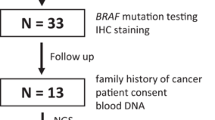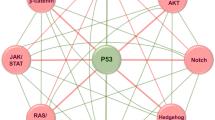Abstract
The contributions and limitations of the traditional method for evaluating microsatellite instability by standard polymerase chain reaction (PCR) in identifying mismatch repair (MMR) gene mutations in the Lynch syndrome form of hereditary nonpolyposis colon cancer (HNPCC) are discussed. A new form of HNPCC (familial colon cancer type X or FCCX), in which deleterious mutations in major MMR genes and microsatellite instability have not been identified, was viewed as possibly having attenuating mutations in MMR genes as its genetic basis. A highly sensitive and quantitative method of microsatellite instability analysis, small-pool PCR, is needed to explore this possibility, and small-pool PCR procedures to address that task must be validated. An algorithm for the use of small-pool PCR to identify patients with FCCX having such attenuating mutations is put forward as a means of detecting single nucleotide polymorphisms (SNPs) for the future diagnosis of cancer in those at risk.
Similar content being viewed by others
References and Recommended Reading
Weber JL: Informativeness of human (dC-dA)n.(dG-dT)n polymorphisms. Genomics 1990, 7:524–530.
Collins JR, Stephens RM, Gold B, et al.: An exhaustive DNA micro-satellite map of the human genome using high performance computing. Genomics 2003, 82:10–19.
Edwards A, Civitello A, Hammond HA, et al.: DNA typing and genetic mapping with trimeric and tetrameric tandem repeats. Am J Hum Genet 1991, 49:746–756.
Loeb LA: Microsatellite instability: marker of a mutator phenotype. Cancer Res 1994, 54:5059–5063.
Ionov Y, Peinado MA, Malkhosyan S, et al.: Ubiquitous somatic mutations in simple repeated sequences reveal a new mechanism for colonic carcinogenesis. Nature 1993, 363:558–561.
Aaltonen LA, Peltomaki P, Leach, FS, et al.: Clues to the pathogenesis of familial colorectal cancer. Science 1993, 260:812–816.
Thibodeau SN, Bren G, Schaid D: Microsatellite instability in cancer of the proximal colon. Science 1993, 260:816–819.
Fishel R, Lescoe MK, Rao MR, et al.: The human mutator gene homolog MSH2 and its association with hereditary nonpolyposis colon cancer. Cell 1993, 75:1027–1038.
Kane MF, Loda M, Gaida GM, et al.: Methylation of the hMLH1 promoter correlates with lack of expression of hMLH1 in sporadic colon tumors and mismatch repair-defective human tumor cell lines. Cancer Res 1997, 57:808–811.
Lynch HT: Genetics, natural history, tumor spectrum, and pathology of hereditary nonpolyposis colorectal cancer: an updated review. Gastroenterology 1993, 104:1535–1549.
Hampel H, Frankel WL, Martin E, et al.: Screen for the Lynch syndrome (hereditary nonpolyposis colon cancer). N Engl J Med 2005, 352:1851–1860.
Risinger JI, Barrett JC, Watson P, et al.: Molecular genetic evidence of the occurrence of breast cancer as an integral tumor in patients with the hereditary nonpolyposis colorectal carcinoma syndrome. Cancer 1996, 77:1836–1843.
Watson P, Lynch HT: Extracolonic cancer in hereditary nonpolyposis colorectal cancer. Cancer 1993, 71:677–685.
Knudson AG, Strong LC: Mutation and cancer: a model for Wilm’s tumor of the kidney. J Natl Cancer Inst 1972, 48:313–324.
Kunkel TA, Erie DA: DNA mismatch repair. Annu Rev Biochem 2005, 74:681–710.
Boland CR, Thibodeau SN, Hamilton SR, et al.: A National Cancer Institute Workshop on Microsatellite Instability for cancer detection and familial predisposition: development of international criteria for the determination of microsatellite instability in colorectal cancer. Cancer Res 1998, 58:5248–5257.
Vasen HF, Mecklin JP, Khan PM, Lynch HT: The International Collaborative Group on Hereditary Non-Polyposis Colorectal Cancer (ICG-HNPCC). Dis Colon Rectum 1991, 34:424–425.
Lindor NM, Rabe K, Petersen GM, et al.: Lower cancer incidence in Amsterdam-I criteria families without mismatch repair deficiency. JAMA 2005, 293:1979–1985.
Lipkin SM, Rozek LS, Rennert G, et al.: The MLH1 D132H variant is associated with susceptibility to sporadic colorectal cancer. Nat Genet 2004, 36:694–699.
Gallinger S, Aronson M, Shayan K, et al.: Gastrointestinal cancers and neurofibromatosis type 1 features in children with a germline homozygous MLH1 mutation. Gastroenterology 2004, 126, 576–585.
Raevaara TE, Korhonen MK, Lohi H, et al.: Functional significance and clinical phenotype of nontruncating mismatch repair variants of MLH1. Gastroenterology 2005, 129:537–549.
Kolodner RD, Putnam CD, Myung K: Maintenance of genome stability in Saccharomyces cerevisiae. Science 2002, 297:552–557.
Hendriks YM, Wagner A, Morreau H, et al.: Cancer risk in hereditary nonpolyposis colorectal cancer due to MSH6 mutations: impact on counseling and surveillance. Gastroenterology 2004, 127:17–25.
Kolodner RD, Tytell JD, Schmeits JL, et al.: Germ-line msh6 mutations in colorectal cancer families. Cancer Res 1999, 59:5068–5074.
Wu Y, Berends MJW, Mensink RGJ, et al.: Germline hMLH3 mutations in patients with suspected HNPCC. Am J Hum Genet 2000, 67(suppl):17.
Guo HH, Loeb SA: Tumbling down a different pathway to genetic instability. J Clin Invest 2003, 112:1793–1795.
Monckton DG, Jeffreys AJ: Minisatellite “isoallele” discrimination in pseudohomozygotes by single molecule PCR and variant repeat mapping. Genomics 1991, 11:465–467.
Yao X, Buermeyer AB, Narayanan L.: Different mutator phenotypes in Mlh1 versus Pms2 deficient mice. Proc Natl Acad Sci U S A 1999, 96:6850–6855.
Coolbaugh-Murphy M, Maleki A, Ramagli L, et al.: Estimating mutant microsatellite allele frequencies in somatic cells by small-pool PCR. Genomics 2004 84:419–430.
Parsons R, Li GM, Longley M, et al.: Mismatch repair deficiency in phenotypically normal human cells. Science 1995, 268:738–740.
Nicolaides NC, Littman SJ, Modrich P, et al.: A naturally occurring hPMS2 mutation can confer a dominant negative mutator phenotype. Mol Cell Biol 1998, 18:1635–1641.
Vilkki S, Tsao JL, Loukola A, et al.: Extensive somatic microsatellite mutations in normal human tissue. Cancer Res 2001, 61:4541–4544.
Wang Q, Lasset C, Desseigne F, et al.: Neurofibromatosis and early onset of cancers in hMLH1-deficient children. Cancer Res 1999, 59:294–297.
Alazzouzi H, Domingo E, Gonzalez S, et al.: Low levels of microsatellite instability characterize MLH1 and MSH2 HNPCC carriers before tumor diagnosis. Hum Mol Genet 2005, 14:235–239.
Vijg J: Somatic mutations and aging: a re-evaluation [review]. Mutat Res 2000, 447:117–135.
Coolbaugh-Murphy M, Xu J, Ramagli LS, et al.: Microsatellite instability (MSI) increases with age in normal somatic cells. Mech Ageing Dev 2005, 126:1051–1059.
Author information
Authors and Affiliations
Corresponding author
Rights and permissions
About this article
Cite this article
Coolbaugh-Murphy, M., Ramagli, L.S. & Siciliano, M.J. Small-pool PCR analysis of microsatellite instability in HNPCC. Curr colorectal cancer rep 3, 185–190 (2007). https://doi.org/10.1007/s11888-007-0029-z
Published:
Issue Date:
DOI: https://doi.org/10.1007/s11888-007-0029-z




